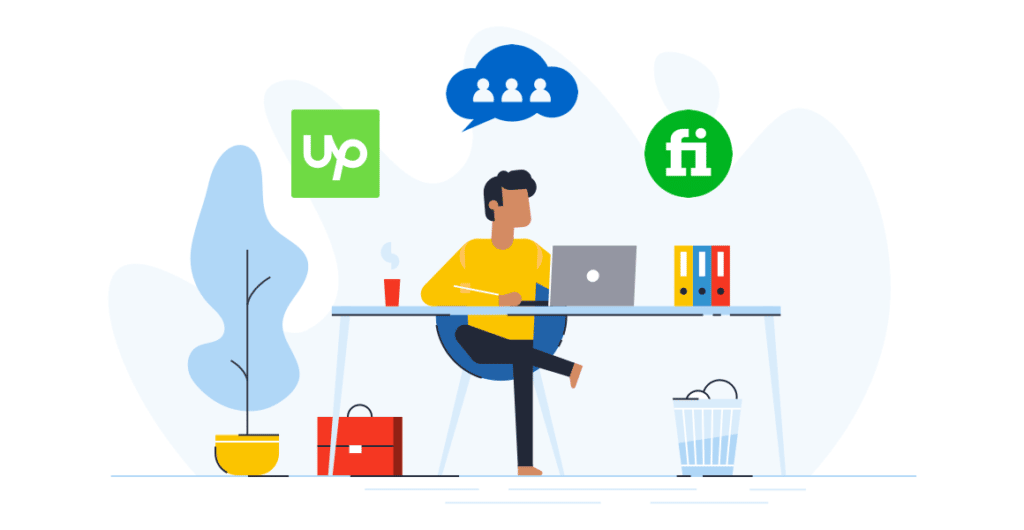Want to start freelancing, but don’t know where to begin? Today we sharing 10 steps to help you how to Start Freelancing as a beginner, along with some helpful resources.
With remote work on the rise, more and more jobs are being outsourced to freelancers and so called “9-to-5” jobs are quickly becoming a thing of the past.
As a result, professionals worldwide are beginning to choose freelancing as their preferred lifestyle thanks to the flexibility, healthy work-life balance, attractive earning potential, and freedom it provides.
Freelancers are able to set their own hours, choose what they’d like to work on as well as who to work with. Indeed, with today’s rising popularity of remote work, competition within the gig economy is expected to soar.
So, are you ready to embrace the freelance revolution and build yourself the solo career you’ve always wanted?
This Ultimate Guide for Freelancers aims to equip you with the tools and advice you need to thrive and survive, because, well, it’s a bit of a jungle out there!
So, let’s dive straight into the guide that will help you build a sustainable freelance career and lead you on the road to success.
How to Start Freelancing as a Beginner
Thinking about getting started in freelancing but don’t know where to start? Then this guide is for you. It’s the ultimate guide on how to start freelancing for beginners.
Whether you want to start freelancing as a writer, web designer, or developer, this guide will help you start your journey in 10 simple steps.
Before you move any further, I need to clarify a few things.
Freelancing is a lot more complicated than you might think. Some people believe anyone with a laptop and an internet connection can earn money online. But, it’s not true.
Continue reading only if you’re willing to work hard to achieve your goal of becoming a freelancer and finding financial freedom.
Now, let’s dive in.
However, bear in mind that this guide only covers the basics. It will help you get started the right way.

1. Get the Right Equipment
Get the right equipment.
You make terrible choices and decisions when you’re desperate. And that’s exactly why I always advise you not to start freelancing to earn money quickly.
Freelancing is not a get-rich-quick scheme. It requires a lot of hard work. In fact, it took me around years to earn a steady income as a freelancer. But, thankfully, today you have more opportunities than I had back then.
I often receive questions from freelancers asking if there is work they can do using just a smartphone. The quick answer is there are none.
At least not ones that are worth doing.
Smartphone apps are limited in features. You need a computer to run the software that is required for doing the work properly and delivering great results.
So, before you go ahead and think about working online, go get yourself a laptop or even an old computer would do the trick.
RESOURCE:
- 50+ Best Tools for Freelancers to Scale a (Real) Business
- A Freelancer’s Toolkit: 18 Tools Everyone Should Use
2. Find A Marketable Skill
Find a skill.
The next, and most important, step is to find a skill you can offer as a service.
This can be something as simple as transcribing a podcast or something advanced like developing a mobile app. Whatever it is, the key to winning in freelancing is to find a skill that you’re good at and has enough demand in the marketplace.
For example, if you’re good at drawing illustrations or designing product packaging, go to a freelance marketplace like UpWork or Freelancer and check to see if there are jobs for that type of work.
If there are enough job listings on those sites for the skill you’re good at, then you’ve hit gold.
3. Polish Up Your Skills
Polish up the skills
Once you find a marketable skill, you should make sure you can offer it as a service. Simply put, you need to be really good at what you do to be able to get paid for it.
For example, let’s say you want to be a freelance writer for health and wellness blogs. This category has good demand. You also have experience writing about it in school or college.
However, that doesn’t mean you can write blog posts for online audiences. Blogs and online publications use very different writing styles and formatting for articles. Mainly to attract general audiences.
So now you need to learn how to write blog posts for online audiences. Learn how to use WordPress or blogger and how to design graphics for articles and more.
It’s the same for every other freelancing skill out there. You can’t just jump right in without even trying to learn the basics. You must polish up your skills first.
Read books, and subscribe to YouTube channels, and blogs related to your skill and industry.
Also, taking online courses is the most effective way to properly learn and polish up a skill.
Developing a skill from scratch takes time. So be patient and keep learning and practicing. It could take weeks, months, or years. Just keep at it.
4. Build Your Reputation
Build reputation.
Being able to prove your skills and work will determine whether you’ll be a successful freelancer or not.
It doesn’t matter if you have a college degree or years of experience. If you can’t prove to clients that you’re skilled at what you do, they will never hire you.
If you’re a writer, you should have articles published on popular blogs. If you’re a graphic designer, you should be able to point to a brand and say you designed their logo. If you’re a web designer, you need to be able to send a link to a website you’ve designed.
In short, get some of your work out there. Do some free work at first if you have to. Reach out to blogs that accept guest posts. Do some concept design work. Whatever it is, work on building your reputation.
5. Create A Portfolio
Create portfolio.
When you start building your reputation, be sure to also create a portfolio to bring all your published/live work into one place.
A portfolio can be a website or a webpage where you showcase all your work.
For example, if you’re a graphic designer, you can create a portfolio page on a site like Behance to show off all your designs. That way, when you’re reaching out to a client, you can simply give them the link to your portfolio to check out your skills.
Make sure to only include your best work in the portfolio.
6. Try Freelancing Part-Time
Try freelance part time.
Freelancing is not everyone’s cup of tea. The process of marketing yourself, selling your services, and dealing with clients can be overwhelming.
If you’re not sure whether freelancing is the right career path for you, just try doing it part-time.
Spend a couple of hours every day working on smaller freelance gigs. And learn the ways of freelancing.
When you feel ready to tackle bigger projects, then you can decide whether you should freelance full-time or leave your day job.

7. Find The Right Freelance Platform
Find the right platforms.
This step plays a crucial part in how easily you’ll land jobs and the quality of the clients you’ll be able to work with.
A mistake most beginning freelancers make is to search for the most popular freelance marketplace and join to get started. Like UpWork or Freelancer.com.
These sites are already filled with millions of freelancers from around the world. And due to the competition, they engage in bidding wars to win jobs. They will constantly lower their prices in order to land the job. And it will get you nowhere.
So the best approach, and the approach that worked wonders for me, is to pick a marketplace that’s fairly new and join it. It’ll have fewer freelancers so you’ll have low competition. And it will increase your chances of landing jobs.
8. Charge The Right Price
Charge the right price.
Figuring out the right price for your services can be challenging. Because if you ask for the wrong price, clients will never even consider hiring you.
In the beginning, the best way to figure out the right price is to go look at popular freelance marketplaces and see what other freelancers in your niche or industry are charging.
Since you’re new, it’s not fair to charge those same prices as experienced freelancers.
Instead, you should try to figure out a middle-ground where you can offer a competitive price than those experienced freelancers without making yourself seem cheap.
9. Send Your First Proposal
Send proposal.
Writing a proposal to a client needs to be done in a careful manner.
It’s not like writing a regular email or writing a social media post. You need to put serious thought into it and figure out how to persuade your client to give you the job instead of all the other freelancers.
There are some tips and hacks you can use to your advantage when writing a winning proposal. I can’t go into all the details here, so please check out the links below for more info on the topic.
10. Deliver Beyond Expectations
Deliver beyond.
Once you land a job, the next step is to make sure that you deliver the project just as the client has asked.
Or, in this case, I want you to over deliver the job by going above and beyond the client’s expectations.
I’ll give you an example. In the early days of my freelancing career, I used to get jobs for writing blog articles with a fixed word count like 1000 words. What I did was write the article to be about 1100-1200 and also include a unique header image for the blog post when delivering it. Without charging extra for it.
The clients were always happy with my work. And gave 5-star ratings.
So find a way to do work that goes beyond expectations. And learn to stand out from the crowd. That’s the only way to build a lasting career as a freelancer.
What’s next?
You are now ready to tackle the world of freelancing. With a lot of dedication and hard work, you’ll be able to create a profitable and prosperous career as a freelancer. That’s a guarantee.
If you want to learn more about freelancing and insights into some of the blueprints that I use to land high-paying clients, please check more articles in the freelancing section.
